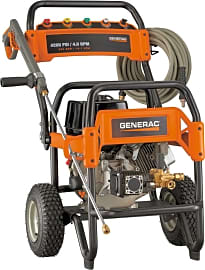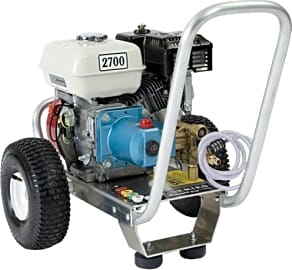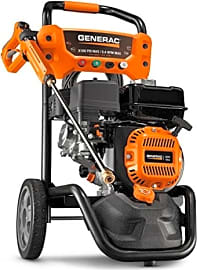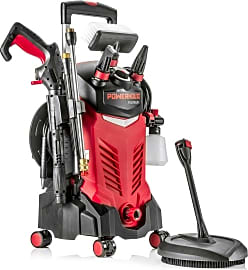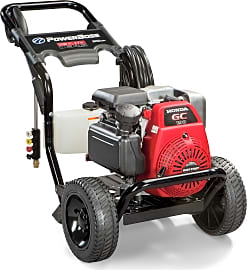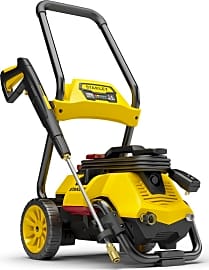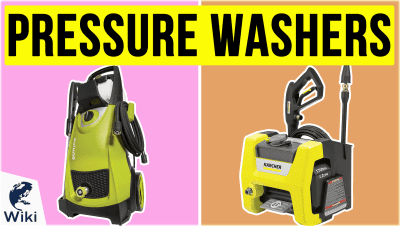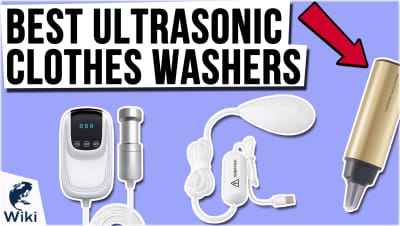The 10 Best Pressure Washers

This wiki has been updated 43 times since it was first published in April of 2015. Whether it's a car, a driveway, a house, or a patio that needs attention, make easy work of any outdoor cleaning project with one of these pressure washers. Available for domestic and professional applications, we've included both gas and electric models with durable pumps, variable pressure controls, multiple nozzle attachments, and extra-long hoses for accessing all those hard-to-reach places. When users buy our independently chosen editorial recommendations, we may earn commissions to help fund the Wiki.
Editor's Notes
November 19, 2020:
We removed the Ford FPWG3100H-J because of repeated complaints of its unreliability, as well as the fact that we already have a superior model with similar specifications in the Wen PW31.
Since we lacked an extra-compact model, we added the Karcher Cube to our list. This is an ultra-light model that would be great for anyone who doesn’t want to lug around a heavy machine. Its 1700 psi wouldn’t be ideal for heavy-duty jobs, but it would be great for lighter projects like washing your car or blasting out trash cans.
We also removed the Simpson PS4240 PowerShot and replaced it with the Simpson ALH4240. The Simpson ALH4240 has the same high, 4200 psi of its predecessor, but lacks the construction and design complaints. It’s definitely on the expensive side, but if you’re looking for a heavy-duty machine that can deliver a massive amount of pressure, this is a great choice.
Regardless of the size or type of pressure washer you purchase, you should always take the time to read and practice its safety protocols. The high pressures they generate are dangerous enough to cause serious injury, so never point the nozzle of a pressure washer at yourself or others. Small objects can even become dangerous projectiles when blasted with a pressure washer spray. Never allow children to use a pressure washer, and keep them at a safe distance when one is being operated by an adult.
If you opt for a gas-powered model, it's extremely important to remember to never use it in an enclosed space. If you do need to pressure wash inside of a partially enclosed space, like a garage, make sure the engine is placed outdoors. If you want to avoid the hassle of gasoline engines altogether, you may want to consider this collection of electric pressure washers.
If you're interested in customizing your pressure washer, this collection of pressure washer guns should provide some high-quality options. Just make sure their hose connections are compatible with the pressure washer you plan on attaching them to.
May 03, 2019:
Pressure cleaners can make short work out of jobs that would otherwise require tons of elbow grease and hours of scrubbing. Since people have different requirements, we thought it prudent to include both high-powered commercial-quality options, as well as more affordable units for home use. If you find yourself needing the former, we recommend the Generac 6565 and Simpson PS4240 PowerShot. Both of these models can withstand heavy use day after day, and they offer 4,200 PSI and a flow rate of four gallons per minute to tackle the most stubborn of grime and stains. The Pressure Pro E3027HC is another model worth pointing out for its commercial-quality build and durability, though it isn't quite as powerful as the previous two options. For the home user, we have included both light- and medium-duty options. For the user who maintains their property well and plans on removing dirt and grime before it has had a chance to really set in, the Sun Joe SPX3000 and Stanley SLP2050 should both be up to the task. Conveniently, they are electric powered too. The Generac OneWash, Powerhouse International Platinum Edition, Wen PW31, PowerBoss 20649, and Ford FPWG3100H-J offer a balance of price and power. They can all handle stubborn stains, be used to strip paint, and tackle other jobs that require a lot of pressure, but won't completely break the bank as the commercial models will. The Powerhouse International Platinum Edition deserves special mention for the large variety of attachments it includes, such as a surface cleaner, angled heads, and a scrub brush.
Energy, Speed, And Water
The water inlet connects the pressure washer to your main water supply and usually has a built-in filter to keep out debris that would otherwise clog the machine.
Depending on the circumstances, cleaning can be a tough job. It takes a considerable amount of elbow grease, time, and the proper resources to clean certain types of surfaces. For example, sponges may be ideal for cleaning your kitchen counters because they quickly soak up hot water and soap, which can be used to scrub away dirt and bacteria. Certain cleaning brushes require similar amounts of elbow grease to clean your bathtub or the walls of your shower with heavy-duty bristles. But what about jobs that require a bit more than a simple scrubbing tool to wash away dirt and debris?
After a harsh storm or a warm summer, you might have leaves and debris stuck in your roof's rain gutters. Your front cement walkway might be full of slippery moss. The exterior paneling or paint along the sides of your home will get dirty and perhaps moldy with so many season changes. You'll need a single tool like a pressure washer to combat these issues and easily clear away dirt and debris with power and minimal effort from you.
Fueled by either cold or hot water, the pressure washer consists of a water pump powered by an electric motor or gas engine to remove debris, dirt, dust, and other contaminants from hard surfaces and buildings. Depending on the device chosen, the water pressure is typically measured in pounds per square inch, and it is adjustable, concentrated, and regulated by the water pump itself. The pump accelerates ordinary tap water from a faucet to a high level of pressure. That water squirts through a hose at high speeds using a trigger gun pointed at the intended surface.
Pressure washers have five main parts that include a water inlet, an electric motor or gas engine, a water pump, a high-pressure hose, and a cleaning attachment. The water inlet connects the pressure washer to your main water supply and usually has a built-in filter to keep out debris that would otherwise clog the machine. Depending on the size of your pressure washer, it may come equipped with either an electric motor or gas engine to power the water pump. Small pressure washers benefit from electric motors running off a domestic power supply, whereas large pressure washers benefit from gasoline-powered engines when electrical outlets are difficult to find. The water pump is driven at high speeds by the motor or engine. When the engine pulls the pump one way, water is sucked in from the faucet (water supply); when the engine pushes the pump another way, the water is expelled outward in the form of a high-pressure jet. The hose runs from the washer to the cleaning attachment you plan to use.
Unlike conventional hoses, a high-pressure hose is constructed with multiple layers of dense plastic and reinforced with wire mesh materials for extra strength and durability. The cleaning attachment can vary from a simple trigger mechanism operated by squeezing a handle, to a spinning wand or rotating brush. The type of attachment depends on the particular application involved. For example, a spinning brush attachment and a high-pressure water jet could help to clear additional brush and debris from one's rain gutters, as opposed to just using a simple trigger gun. However, the trigger gun may prove more practical for pressure washing dirty shingle siding.
What is the benefit to using water in this way? Water molecules have a certain amount of electrical polarity. With a high degree of kinetic energy from the pressure washer, water can easily hit tough substances like dirt and wash them away quickly.
A Brief History Of The Pressure Washer
The pressure washing industry dates back to the 1920s in the days of prohibition. Pennsylvania employee and whiskey still maker Frank W. Ofeldt II discovered (by accident) that when high-pressure steam was forced through a hose, the steam could be used to quickly clean grease from his garage floor.
The first hot water pressure washer was invented in 1950 by inventor and entrepreneur Alfred Kärcher. Kärcher died only nine years later with the future of his business being dependent upon his wife. Within twenty years, Kärcher's wife successfully marketed his design at an international level.
Since that time, pressure washers have evolved to include additional cleaning attachments, more powerful motors, adjustable water jets and pressure settings, and stronger hoses built to withstand extended use.
Finding Pressure Without Being Under It
The power and precision needed for a pressure washer really is dependent upon its intended use. The good news is that a pressure washer can be applied to many domestic cleaning jobs. If your plan is to use your washer occasionally for spring cleaning duties, then a less expensive model with an electric motor that is easy to transport to different rooms will be a good choice. If you consider yourself a power washer and fix-it person, then it's worth the extra investment for a large pressure washer with a long and durable hose for reaching almost anywhere around and outside your house.
The best pressure washers deliver variable speed and pressure controls, so you can adjust the unit to suit specific cleaning jobs without wasting excess water.
Storage can be a big consideration during the seasons when you won't use the pressure washer. For that reason, finding one that features fold-down handles can make all the difference when you're trying to save space.
The best pressure washers deliver variable speed and pressure controls, so you can adjust the unit to suit specific cleaning jobs without wasting excess water. This is especially useful in places where water conservation is important during times of drought.
Finally, pay close attention to the type of trigger with which your intended pressure washer is equipped. As you will be holding onto it for extended periods of time, it's important for the trigger to be comfortable enough to hold without causing fatigue.


